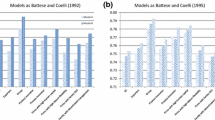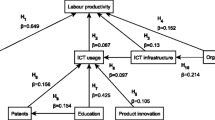Abstract
The lack of empirical support for the positive economic impact of information technology (IT) has been called the IT productivity paradox. Even though output measurement problems have often been held responsible for the paradox, we conjecture that modeling limitations in production-economics-based studies and input measurement also might have contributed to the paucity of systematic evidence regarding the impact of IT. We take the position that output measurement is slightly less problematic in manufacturing than in the service sector and that there is sound a priori rationale to expect substantial productivity gains from IT investments in manufacturing and production management. We revisit the IT productivity paradox to highlight some potential limitations of earlier research and obtain empirical support for these conjectures. We apply a theoretical framework involving explicit modeling of a strategic business unit's (SBU)1 input choices to a secondary data set in the manufacturing sector. A widely cited study by Loveman (1994) with the same dataset showed that the marginal contribution of IT to productivity was negative. However, our analysis reveals a significant positive impact of IT investment on SBU output. We show that Loveman's negative results can be attributed to the deflator used for the IT capital. Further, modeling issues such as a firm's choice of inputs like IT, non-IT, and labor lead to major differences in the IT productivity estimates. The question as to whether firms actually achieved economic benefits from IT investments in the past decade has been raised in the literature, and our results provide evidence of sizable productivity gains by large successful corporations in the manufacturing sector during the same time period.
Similar content being viewed by others
References
Baily, M.N. and Chakrabarti, A., Innovation and the Productivity Crisis, Brookings Institution, Washington, DC (1988).
Baily, M.N. and Gordon, R.J., “The Productivity Slowdown, Measurement Issues and the Explosion of Computer Power,” in Brookings Papers on Economic Activity, Vol. 19, No. 2 (1988).
Barua, A., Kriebel, C.H., and Mukhopadhyay, T., “An Economic Analysis of Strategic Information Technology Investments,” MIS Quarterly, Vol. 15, No. 3 (1991).
Barua, A., Kriebel, C.H., and Mukhopadhyay, T., “Information Technologies and Business Value: An Analytic and Empirical Investigation,” Information Systems Research, Vol. 6, No. 1 (March 1995).
Barua, A., Lee, C.-H., and Whinston, A.B., “Incentives and Computing Systems for Team-Based Organizations,” Organization Science, Vol. 6, No. 4 (1995).
Barua, A., Lee, C.-H., and Whinston, A.B., “The Calculus of Reengineering,” Information System Research, Vol. 7, No. 4, pp. 409-428 (1996).
Berndt, E.R. and Wood, D.O., “Technology, Price, and the Derived Demand for Energy,” The Review of Economics and Statistics, Vol. 3, pp. 259-268 (Aug. 1975).
Bodea, S.A., “Information Technology and Economic Performance: Is Measuring Productivity Still Useful?,” WP No. 94-8, Harvard University, Center for Information Policy Research (1994).
Brynjolfsson, E., “Information Technology and the Productivity Paradox: Review and Assessment,” Communications of the ACM, Vol. 35, pp. 66-77 (Dec. 1993).
Brynjolfsson, E. and Hitt, L., “Is Information Systems Spending Productive? New Evidence and New Results,” Proceedings of the 14th International Conference on Information Systems, Orlando, FL (1993).
Bureau of Labor Statistics, Trends in Multifactor Productivity, U.S. Department of Labor, Washington, DC (1983).
Cerveny, R.P. and Scott, L.W., “A Survey of MRP Implementation,” Production and Inventory Management, Vol. 30, No. 3, pp. 31-34 (1989).
Christensen, L.R. and Greene, W.H., “Economies of Scale in U.S. Electric Power Generation,” Journal of Political Economy, Vol. 84, No. 4, pp. 654-676 (Aug. 1976).
Christensen, L.R. and Jorgenson, D.W., “The Measurement of U.S. Real Capital Input, 1929-1967,” Review of Income and Wealth, Vol. 15, No. 4, pp. 293-320 (1969). “
CITIBASE: FAME Economic Database,” FAME Information Services Inc., New York, NY (1992).
Clemons, E.K. and Kimbrough, S.O., “Information Systems and Business Strategy: A Review of Strategic Necessity,” Working Paper, The Wharton School, University of Pennsylvania (1987).
Dos Santos, B.L., Peffers, K., and Mauer, D.C., “The Impact of Information Technology Investment Announcements on the Market Value of the Firm,” Information Systems Research, Vol. 4, No. 1, pp. 1-23 (Sept. 1992).
Douma, S. and Schreuder, H., Economic Approaches to Organizations, Prentice-Hall, Englewood Cliffs, NJ (1992).
Duchessi, P., Schaninger, C.M., Hobbs, D.R., and Pentak, L.P., “Determinants of Success in Implementing Material Requirements Planning,” Journal of Manufacturing and Operations Management, Vol. 1, No. 3, pp. 263-304 (1988).
Gordon, R.J., “What are Computers Doing in the Service Sector? Are They Unproductive, and If So, Why?,” Notes from Presentation at Panel Discussion on Information Technology and the Productivity Paradox, 10th ICIS, Boston (Dec. 1989).
Grosskopf, S., “Efficiency and Productivity,” in The Measurement of Productive Efficiency: Techniques and Applications, H.O. Fried, C.A. Knox Lovell, and S.S. Schmidt (Eds.), Oxford University Press, New York, NY (1993).
Hausman, J.A., “Specification Tests in Econometrics,” Econometrica, Vol. 46, No. 6, pp. 1251-1271 (Nov. 1978). Heizer, J. and Render, B., Production and Operations Management, Allyn and Bacon, Boston (1988).
Kauffman, R.J. and Kriebel, C.H., “Measuring and Modeling the Business Value of IT,” Measuring Business Value of Information Technologies, ICIT Research Study Team (Eds.) No. 2, ICIT Press, Washington D.C. (1988).
Kreps, D., A Course in Microeconomic Theory, Princeton University Press, Princeton, NJ (1990).
Kumbhakar, S.C., “The Specification of Technical and Allocative Inefficiency in Stochastic Production and Profit Frontiers,” Journal of Econometrics, Vol. 34, pp. 335-348 (1987).
Lichtenberg, F., “The Output Contributions of Computer Equipment and Personnel: A Firm Level Analysis,” Columbia Business School working paper (Oct. 1993).
Loveman, G.W., “An Assessment of the Productivity Impact of Information Technologies,” in Information Technology and the Corporation of the 1990s: Research Studies, T.J. Allen and M.S. Scott Morton (Eds.), MIT Press, Cambridge, MA (1994).
Martin, E.W., DeHayes, D.W., Hoffer, J.A., and Perkins, W.C., Managing Information Technology, Macmillan Publishing Company, New York (1991).
Milgrom, P., and Roberts, J., “The Economics of Modern Manufacturing: Technology, Strategy, and Organization,” American Economic Review, pp. 511-528 (June 1990).
Morrison, C.J. and Berndt, E.R., “Assessing the Productivity of Information Technology Equipment in the U.S. Manufacturing Industries,” National Bureau of Economic Research, Working Paper No. 3582 (1990).
Roach, S.S., “America's Technology Dilemma: A Profile of the Information Economy,” Special Economy Study, Morgan Stanley & Co., San Mateo, CA (1987).
Schmidt, P. and Knox Lovell, C.A., “Estimating Technical and Allocative Inefficiency Relative to Stochastic Production and Cost Frontiers,” Journal of Econometrics, Vol. 9, pp. 343-366 (1979).
Schroeder, R.G., Anderson, J.C., Tupy, S.E., and White, E.M., “A study of MRP Benefits and Costs,” Journal of Operations Management, Vol. 2, No. 1, pp. 1-9 (1981).
Senn, J.A., Information Systems Management, Wadsworth Publishing Company, Belmont, CA (1990).
TSP International, TSP User's Guide: Version 4.2
“The Technology Payoff,”Business Week, pp. 57-79 (June 14, 1993).
Solow, R.M., “We'd Better Watch Out,” New York Times, July 12, 1987, p. 36.
Vonderembse, M.A., and White, G., Operations Management: Concepts, Methods, and Strategies, West Publishing Company, Eagan, MN (1998).
WEFA Group Report, U.S. Long-Term Economic Outlook: Trend/Moderate Growth Scenario, Third Quarter, 1994, Vol. 1 (1994).
Weill, P., “The Relationship Between Investment Information Technology and Firm Performance: A Study of the Value Manufacturing Sector,” Information Systems Research, Vol. 3, No. 4, pp. 307-333 (1992).
Yeo, K.T., Ong, N.S., and Wong, S.S., “A Survey on the Application of MRP in Singapore,” Proceedings of the International Conference of Industrial Engineering, Singapore (1988).
Author information
Authors and Affiliations
Rights and permissions
About this article
Cite this article
Barua, A., Lee, B. The Information Technology Productivity Paradox Revisited: A Theoretical and Empirical Investigation in the Manufacturing Sector. International Journal of Flexible Manufacturing Systems 9, 145–166 (1997). https://doi.org/10.1023/A:1007967718214
Issue Date:
DOI: https://doi.org/10.1023/A:1007967718214




